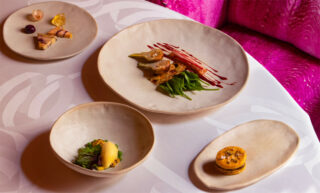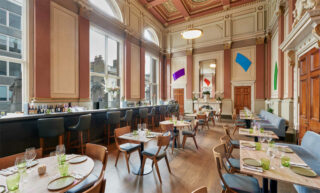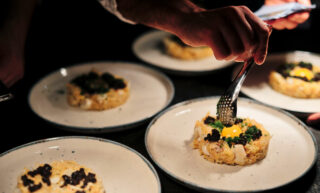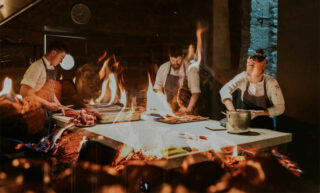From Brasserie to Gastro-Theatre
A celebration spawning over more than a year, Heston Blumenthal and his team commemorate the 25th anniversary of The Fat Duck in Bray, west of London, with five anthology menus featuring his most iconic dishes.
A quarter of a century in business, most of the time at the highest culinary level, is a big feat. Being able to weather the persistent pressure to perform flawlessly, and to be creative and innovative isn’t easy. But when I speak to Ed Cooke, who has worked with The Fat Duck for 12 years and is since half a year Blumenthal’s first man there, you barely notice it. He looks healthy and is calm and relaxed. “Although we are currently understaffed, like almost every restaurant these days, we try to pay attention to a good work/life balance.” Freshly shaven, dark blond hair impeccably combed back and dressed in a clean, short-sleeved, white chef’s jacket, he sits down with me for coffee one early Wednesday morning in March to reflect on the last 25 years. A month before I had enjoyed the third anthology menu.
Question Everything
The Fat Duck is inextricably connected with the person of Heston Blumenthal, who constantly injects it with his creativity and the findings of his inquisitive mind. Over the years he made the restaurant famous with innovative ideas that can roughly be grouped around three themes: Foodpairing, multi-sensory experience and historical research. His attitude is first and foremost characterised by his motto Question Everything, which adorns his coat of arms that he has carried since he was appointed an OBE for his services to British gastronomy in 2006. It is also shaped by what he wrote (together with Ferran Adrià, Thomas Keller and Harald McGee) in his manifesto New Cookery, which, freely summarized, makes the case for excellence, openness, integrity and new techniques without forsaking traditions in the kitchen. All aspects run like red threads through the dishes on the menu and are drenched in a good amount of nostalgia and childhood memories.
Umami bomb
Foodpairing is based on the scientific insight that, at a molecular level, certain ingredients could show similarities, suggesting they may pair well. Although there could be other reasons, such as texture, why the ingredients don’t match, it can be a starting point for a new dish. Ed Cooke shows me the website (foodpairing.com) his team consults regularly. On the anthology menu I was served, there were at least three dishes that were to some degree influenced by the idea of foodpairing, the crab risotto probably being the best known. Like many risottos, this one also contained Parmesan cheese, something that, certainly at the time of introduction in 1998, made eyebrows rise. Seafood and cheese? Yikes! But both crab and Parmesan contain high amounts of umami compounds, and hence Heston gave it a shot. By introducing a savoury (crab) ice cream, also a novelty, he created a temperature contrast as well. It is a dish that has certainly withstood the test of time. A rich umami bomb, the ice cream tricked my senses because it felt and tasted almost like a velvety pâté de foie gras.
Beach memories
In Sound of the Sea (2007) Blumenthal has taken multi-sensory dining to a new level. While listening to waves lapping the shore on a pair of earphones that are connected to a device in a big shell, you eat a seafood dish plated as if it were that same beach you are hearing. Sand is made of tapioca starch, the waves are a foamy concoction of kombu and shiitake, while cured halibut, cooked and grilled octopus, pieces of yellowtail and sea greens represent the rubble that has washed up on the shore. The plate, on which this is served, is a rectangular box with a glass lid filled with sand and shell fragments. It is evocative, and it does bring up memories of childhood holidays at the Mediterranean, but the headphones also distract from the food, to an extent that I can’t say if the dish was great or disappointing.
Sound of the Sea ©TFD
Unctuous blackpudding
The main course, Anjou pigeon (from 2007) is one of the dishes that have a link to Blumenthal’s penchant for historical research. It hails back to a recipe from an English cookbook from 1390. Gently heated, succulent meat is served alongside unctuous blackpudding and crispy chicken skin. Wafts of fragrant spices (cinnamon, cardamon, star anise, etc.), placed on the table in a separate glass bowl, give sensory support to the spices in the dish itself – another example of multi-sensory dining.
Good vibrations
Celebrating your anniversary with a yearlong grand parade of your best dishes inevitably raises the question of what will be next. Is it the final curtain or just the end of a chapter? Ed Cooke answers without a blink. They are already brainstorming about The Fat Duck 3.0, to be launched in 2023. It’s still in its infancy and he can’t say much about it, but he offered a glimpse of what we may expect. And it’s typically nerdy. Blumenthal is encouraging Ed and his team to elaborate on his new ideas, for example around the theme Vibration. Apparently, a Japanese study has shown that vibrated water, when frozen, produces different types of ice crystals than unvibrated water. How this translates into something edible on the plate remains shrouded in mist.
Continuous evolution
As The Fat Duck has somewhat fallen off the radar since it was The World’s Best restaurant in 2005 – it hasn’t featured in the list since 2014 –, a reset might be needed, although in the current format it is unlikely The Fat Duck can reenter the competition. Ed looks a bit nonplussed when I bring up this topic. He blames it on the location. Once the ‘judges’ are done in London, he assumes, there is no time left to come to Bray. As Bray is just 30 miles upstream along Thames from Trafalgar Square, it feels far-fetched. A point of criticism that is often heard, is the fact The Fat Duck recycles too many of its existing dishes, something that resonates with Ed. However, he gives it a positive twist. “Dishes at The Fat Duck are never finished and always evolve.” The Anjou Pigeon, that started off as a confit of pigeon with cherries is a point in case. But also the Veal Sweetbread smoked in Hay has undergone drastic change since its first appearance in 1999, when it was a more “brasserie-style dish”, as Ed says. While the sweetbread used to be breaded and deep-fried , it is now glazed and served with truffle, and refined with hay smoke and bee pollen. The accompanying humble parsnip, fresh and soft, but still with a bite, may well be the best in its kind I have ever eaten.
Reminiscences
That Blumenthal has been influential is beyond doubt. Several times my mind wandered off to memorable dishes from other chefs that seemed to lean on Blumenthal’s experimentation. In his dish Bassa e Alta marea (low and high tide), chef Accursio Craparo of restaurant Accursio in Modica (Sicily) depicts the algae-clad rocks lining the Sicilian coast that are alternately sprayed and flooded by the salty seawater or exposed to the beating Mediterranean sun. In hindsight I suspect he must have taken his cue from Sound of the Sea. I was also reminded of Grant Achatz’s intelligent cooking style at Alinea in Chicago that tries to engage the diner in similar ways as Blumenthal – think of the thin slice of Wagyu beef, artfully mounted on a mini easel, which was placed at the table as a conversation piece some time before the dish it was part of was served.
The bee pollen and smoked hay (in the veal dish) reminded me of an excellent dessert by Thomas Dorfer at Landhaus Bacher west of Vienna consisting of a scoop of beeswax ice cream, a big blob of propolis (bee glue) gel and a dab of fresh, unpasteurized milk infused with burnt hay and whipped up into an utterly delicious cream.
Science and theatre
With a card game, an automaton churning out the mignardises shaped in the form of a huge doll’s house, a magnifying glass (for researching and questioning everything?), adjustable table lights to set the best stage for each dish, fragrant sprays behind your back to augment the flavours and aromas of a nitrogen aperitif, accompanying sound, service staff who are storytellers, diners who are questioneers: Blumenthal’s cuisine – it is way more than cuisine, it is science and gastro theatre too –, is distinctly playful. This theatricality may or may not be to your taste, but when you try to get into Blumenthal’s mind, which requires an effort, you’ll find many a marvel. In any case, the anthology menus are a great way to experience the vast achievements of one of the most innovative chefs of his generation.
The Fat Duck
High Street,
Bray
Berkshire
SL6 2AQ
UK
T: +44 1628 580333
A version of this article (in Norwegian) has been published in Apéritif (issue 3 2022)







Comments